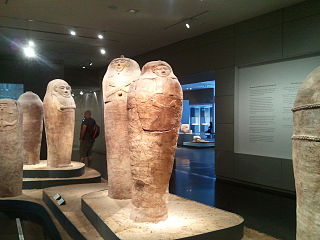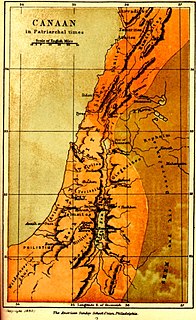 W
WCanaan was a Semitic-speaking civilization and region in the Ancient Near East during the late 2nd millennium BC. The name "Canaan" appears throughout the Bible, where it corresponds to the Levant, in particular to the areas of the Southern Levant that provide the main setting of the narrative of the Bible: Phoenicia, Philistia, Israel, and other nations.
 W
WAamu was an Egyptian name used to designate Western Asiatic foreigners in antiquity. It is generally translated as "Western Asiatic", but suggestions have been made these could be identical with the Canaanites or the Amorites.
 W
WThe Amorites were an ancient Semitic-speaking people from Syria who also occupied large parts of southern Mesopotamia from the 21st century BC to the end of the 17th century BC, where they established several prominent city states in existing locations, such as Isin, Larsa and later notably Babylon, which was raised from a small town to an independent state and a major city. The term Amurru in Akkadian and Sumerian texts refers to both them and to their principal deity.
 W
WThe anthropoid ceramic coffins of the Late Bronze Age Levant are a unique burial practice that is a synthesis of Egyptian and Near Eastern ideologies. The coffins date from the 14th to 10th centuries BCE and have been found at Deir el-Balah, Beth Shean, Lachish, Tell el-Far’ah, Sahab, and most recently in the Jezreel Valley in 2013. The coffins show Egyptian influence in the Ancient Near East and exhibit many Egyptian qualities in the depictions on the face masks on the lids. The lids can be separated into two artistic categories, the natural and grotesque, and the bodies are separated into type A, tapered from the shoulders, and type B, cylindrical. The graves contain wealthy funerary offerings from a variety of origins from Cyprus, Mycenae, Egypt, Phoenicia, and Canaan. The graves appear to be originally reserved for Egyptian officials and then later became a part of Canaanite and Philistine culture.
 W
WThe Pítati (pí-ta-ti) were a contingent of archers of ancient Egypt that were often requested and dispatched to support Egyptian vassals in Canaan. They are recorded in the correspondence of the 1350 BC Amarna letters, and were often requested to defend against the Habiru, also rogue vassal-kings and foreign troops of neighboring kingdoms, who were on the attack.
 W
WBen-Azen was an Asiatic official in the 19th Dynasty of ancient Egypt at the court of Pharaohs Ramses II and his son, Merneptah. Ben-Azen's was titled: "Cup Bearer", meaning he was in a high position stationed next to the kings themselves despite his foreign descent that allegedly should have restricted him to menial tasks.
 W
WA Canaanean blade is an archaeological term for a long, wide blade made out of stone or flint, predominantly found at sites in Israel and Lebanon. They were first manufactured and used in the Neolithic Stone Age to be used as weapons such as javelins or arrowheads. The same technology was used during the later Chalcolithic period in the production of broad sickle blade elements for harvesting of crops. Canaanean blades were also used in the threshing of cereal grains. This indicates the presence of early agricultural technologies. The blades would be attached to a small wooden platform with bitumen. The platform, with a human or other weight standing on it, was then pulled behind an animal across a threshing floor. The forward motion of the animal paired with the downward force of weight exerted through the blades served to cut grain into small pieces.
 W
WThe Hyksos were people of probable Levantine origin, who established the Fifteenth Dynasty of Egypt based at the city of Avaris in the Nile delta, from where they ruled the northern part of the country. While the Hellenistic Egyptian historian Manetho portrayed the Hyksos as invaders and oppressors, modern Egyptology no longer believes that the Hyksos conquered Egypt in an invasion. Instead, Hyksos rule had been preceded by groups of Canaanite peoples settled in the eastern delta who probably seceded from central Egyptian control near the end of the Thirteenth Dynasty.
 W
WTel Kabri is an archaeological tell containing one of the largest Middle Bronze Age Canaanite palaces in Israel, and the largest such palace excavated as of 2014. Kabri is named for the abundance of its perennial springs the presence of which has led to the site's occupation and use as a water source from the Pottery Neolithic (PN) period to the present day. Located in the Western Upper Galilee, the site was at the height of its power in the Middle Bronze, controlling much of the surrounding region. Kabri declined as a local power at the end of the Middle Bronze, but the site continued to be occupied at times, on a much reduced level, up until the 1948 Arab-Israeli War.
 W
WThe Battle of Kadesh or Battle of Qadesh took place between the forces of the New Kingdom of Egypt under Ramesses II and the Hittite Empire under Muwatalli II at the city of Kadesh on the Orontes River, just upstream of Lake Homs near the modern Lebanon–Syria border.
 W
WCanaan was a Semitic-speaking civilization and region in the Ancient Near East during the late 2nd millennium BC. The name "Canaan" appears throughout the Bible, where it corresponds to the Levant, in particular to the areas of the Southern Levant that provide the main setting of the narrative of the Bible: Phoenicia, Philistia, Israel, and other nations.
 W
WPawura, and also: Pauru, Piwure, Puuru/Puwuru was an Egyptian official of the 1350–1335 BC Amarna letters correspondence. As mentioned in letter no. 171, he was also an Egyptian "archer–commander". In letter no. 289 he is called an "irpi–official". In Egyptian his name means 'the Great One', (Pa-wr/Pa-ur)(letter EA 287:45-"1.-Pa-Ú-Ru")
 W
WThe Promised Land is the land which, according to the Tanakh, was promised and subsequently given by God to Abraham and his descendants, and in modern contexts an image and idea related both to the restored Homeland for the Jewish people and to salvation and liberation is more generally understood.
 W
WCanaanite religion refers to the group of ancient Semitic religions practiced by the Canaanites living in the ancient Levant from at least the early Bronze Age through the first centuries of the Common Era.
 W
WYahwism was the historic monolatristic/henotheistic worship of Yahweh in the ancient Israelite kingdoms of Judah and Israel (Samaria), Yahweh being one of the many gods and goddesses of the pantheon of gods of the Land of Canaan, the southern portion of which would later come to be called the Land of Israel. Yahwism thus evolved from Canaanite polytheism, which in turn makes Yahwism the monolatristic primitive predecessor stage of Judaism in Judaism‘s evolution into a monotheistic religion.